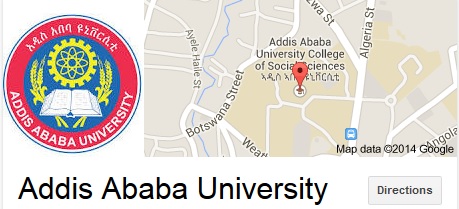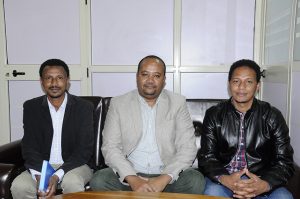The Ethiopian Ancient Education System, ‘Abǝnnät Tǝmhǝrt’, Needs Attention

The joint Ethiopian-German project, “Documenting an Ancient Education System in Africa: Abǝnnät Tǝmhǝrt in Ethiopia”, had its official starting on the 1st of October 2021, with the collaboration of the host institute-Hiob Ludolf Center for Ethiopian Studies, University of Hamburg, Germany.
The launching of the project on an ancient education system namely, the ‘Abǝnnät Tǝmhǝrt’, intends to add the reputation of AAU’s effort to internationalize its institutional appearance and research endeavours.
The project concept claims that the living tradition of church education in Ethiopia has been scarcely documented and less analysed academically. Due to the literacy dominance in modern secular education establishments and priests educated in theological colleges, the ancient ways of transmission of knowledge are in danger of becoming gradually obsolete.
“The practices and contents, including valuable manuscripts containing the texts that have to
be studied, fall out of use; manuscripts deteriorate and are replaced, when needed, by printed media. It is of high importance to preserve both tangible and intangible aspects of this cultural heritage, documenting the oral and written practices,” the project concept added.
Principal investigators, Prof. Alessandro Bausi (Hamburg University) and Assoc. Prof. Mersha Alehegne (Addis Ababa University-AAU), supported by three PhD students (Addisie Yalew, Senkoris Ayalew and Tsehay Ademe), together will run the project for two years.
The PhD students shall be aiming at identifying and documenting the endangered content (all teaching and learning practices, whether based on written text or oral transmission) of the Ethiopian ecclesiastical scholarship through traditional and digital means, providing an objective description of these methods.
They will also help to cooperate for documenting and wherever possible safeguarding the actual material aspects of the traditional education, namely the manuscripts used (now or in the past) by the teachers and the students found in the actual trends of the system.
Mersha Alehegne (PhD), expert in studying ancient manuscripts, College of Humanities, Department of Linguistics and Philology at AAU and the co-leader of the Joint Project, together with the two PhD students (among the three), told the AAU staff reporters as follows:
Associate Prof. Mersha Alehegne:
“‘Abǝnnät Tǝmhǝrt’, the oldest education system in Ethiopia, had been educating the country and producing scholars for both the palace and the church since its inception. But since the advent of the Euro Centric modern education in 1900 E.C, is weakening, even though it still has scholars, schools and students.
When we study this ancient education system curriculum in a scientific way, it is very advanced in theory; the methods are very sophisticated; and it can contribute much to the world beyond us.
I wrote a project saying that we need to study and document because the culture is weakening, even the old culture that we used to study the Ge’ez alphabet is now disappearing and agreed to work together with The Gerga Henkel Foundation.
Although there is a main focus on the oral instruction of the ancient ‘Abǝnnät Tǝmhǝrt’ education system, documentation and related cultures will also be studied and documented together.
As this ancient education system is a resource not only for Ethiopia but also for Africa as a whole, the new project intends to examine the challenges that the system faced and provides information on what to do.
The main reason for the risk of disappearing the ‘Abǝnnät Tǝmhǝrt’ as we have seen it in research, the most knowledgeable scholars in this system are in trouble, they lost their places and moved to cities to become day labourers. As a result of this, a number of traditional schools have been closed and students have been dispersing.”
Tsehay Ademe (PhD student at AAU):
“Although I do not know when the study of the ‘Abǝnnät Tǝmhǝrt’ began, there is an oral tradition that dates back to before Christ. After that, however, it is possible to cite a variety of hymns from the 6th century onwards; St. Yared is said to have contributed unforgettable works used as bases for the ancient education system.
Over time, many cultures of the ancient education system are changed; especially since the Derg regime, it has been the most pushed but very astonishingly still existing system, with danger of going down to extinction is there, however.
The three basic functions of a university (teaching, research and social service) are practical in the ‘Abǝnnät Tǝmhǝrt’. From the moment the student starts school, he will serve the community attending the church service at night, at weddings, and mourning ceremonies, etc.”
Senkoris Ayalew (PhD student at AAU and Ge’ez lecturer at Gondar University):
“When we talk about ‘Abǝnnät Tǝmhǝrt’, the church and the scholars are together, there are the disciples, moral and values; the time the ancient education system took sovereignty over national culture, there was no social upheaval.
If modern education had its origins from ‘Abǝnnät Tǝmhǝrt’ in Ethiopia, combined with model of teaching, such as oral inheritance, memory, creation, explanation, continuation, and so on, it would be nice for the country not to be dominated by cultures and traditions from overseas.
A modern education student takes the overview points of the teacher or cannot take all the points literally but the ancient education system could have been a great help in this regard; ethics lessons are taught from the lower to the uppermost levels in ‘Abǝnnät Tǝmhǝrt’ indicating what is ethical and not.”
Mersha Alehegn (PhD):
“The ‘Abǝnnät Tǝmhǝrt’ has a comprehensive and sound curriculum which passes through ‘Nibab Bet’, ‘Zema’, ‘Akuakuam,’ ‘Kine’ and ‘Yemtsihaf Tiriguame’, including skill education; there are two types of courses: one is the basic education and the other is the certification.
Enhancing or nurturing the ‘Abǝnnät Tǝmhǝrt’ schools should not be left to the Orthodox Church only; governments, especially universities, need to work on this. Erecting a church building alone does not help; there should be a large number of priests who can serve in the church building tomorrow.
Although the basics for the ‘Abǝnnät Tǝmhǝrt’ are religious, there are many other things that are of national importance; it contains a potential scientific knowledge like hard science including engineering.
In modern education, a student goes into practice for a very short time (one or two months) before graduation; however, the practice of ancient education begins with the introduction of the subject (From Day One); it is always learning by doing.
It is unfortunate that there is not yet such a large centre for Ge’ez, the medium of instruction for the ‘Abǝnnät Tǝmhǝrt’. The Germans, however, are working on it as the Centre of Excellence, but we did not do much to solve the problem in our case.”
Tsehay Ademe:
“Ge’ez education is based on religion, but there is no field of knowledge that cannot be touched. I don’t think we need to look anywhere, especially when it comes to humanities. It has more than enough. Ge’ez has a number of subtle mysteries, including philosophy and psychology.”
Mersha Alehegne (PhD):
“We have a plan to organize a workshop on the ‘Abǝnnät Tǝmhǝrt’ project issue and discuss it at the university level, where officials intended to join. The project is a joint venture between the AAU and Hamburg University. Although the study is conducted here, the result is shared by both Universities.
Supporting the project with manpower, finance and materials, would be good for AAU to own it. I suggest AAU to open a department or program where ‘Abǝnnät Tǝmhǝrt’ to be studied. With it, more research can be done; more professionals can come and more work can be done and the project will further promote Ethiopia in terms of education.”
By: Abraham Girmay
Photo: Andualem Aseffa

















 The main Admission Office It is located on the Main Campus (at Sidist Kilo) of Addis Ababa University.
The main Admission Office It is located on the Main Campus (at Sidist Kilo) of Addis Ababa University.









